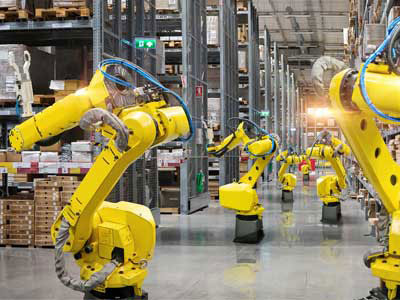Key Takeaway
The main objective of industrial robots is to optimize production processes. They achieve this by enhancing efficiency, precision, and consistency in manufacturing tasks. Industrial robots can handle repetitive and hazardous jobs, reducing human error and workplace injuries. They are adaptable to various tasks, making production lines more flexible. By improving speed and accuracy, industrial robots help in meeting customer demands effectively. Overall, their goal is to boost productivity, ensure high-quality output, and lower operational costs in industrial settings.
Automating Repetitive Tasks
Automating repetitive tasks can significantly enhance efficiency and productivity in industrial operations. By leveraging advanced automation technologies, such as PLCs, sensors, and robotics, businesses can streamline production processes, reduce human error, and achieve consistent quality output. Automation also frees up human resources for more complex and creative tasks, leading to overall cost savings and improved competitiveness. Embracing automation not only boosts operational efficiency but also ensures compliance with stringent industry standards, making it a pivotal strategy for modern manufacturing and industrial applications.

Enhancing Production Speed
Industrial robots revolutionize production speed by operating continuously without breaks or fatigue. Unlike human workers, who need rest and can experience weariness, robots maintain a consistent, high-speed pace throughout the entire day. This ability to work around the clock significantly increases the throughput of manufacturing processes. In industries like automotive manufacturing, high-speed robots are particularly advantageous. They can rapidly assemble parts, apply coatings, and conduct inspections much faster than human workers. This consistent speed and efficiency allow companies to meet tight deadlines and quickly respond to market demands.
Moreover, the utilization of high-speed robots in production lines helps in reducing bottlenecks and streamlining the manufacturing process. This continuous and rapid operation not only enhances productivity but also provides companies with a competitive edge. By meeting and exceeding production targets, businesses can cater to a larger market share and improve their overall profitability. This increase in production speed through robotic automation is a key factor in modern manufacturing, driving both growth and innovation.
Ensuring Quality and Precision
Industrial robots play a crucial role in ensuring quality and precision in manufacturing processes. These robots are designed to execute tasks with exceptional accuracy, which is vital for producing complex products with stringent tolerances. For instance, in the electronics industry, robots are employed to place minuscule components on circuit boards with extreme precision. This high level of accuracy significantly reduces the risk of defects, thereby enhancing the overall quality of the final product. Robots also consistently perform quality control inspections, identifying and rectifying issues before they impact the final output.
The ability of robots to perform with such precision and reliability is unparalleled. This consistent performance ensures that every product manufactured meets the required standards, thus maintaining the brand’s reputation for quality. By integrating robots into the production line, companies can minimize human errors, which are often the cause of product defects. This precision not only improves product quality but also reduces waste and rework, ultimately leading to cost savings and higher customer satisfaction.
Improving Workplace Safety
One of the significant advantages of using industrial robots is the improvement of workplace safety. Robots can take over dangerous tasks such as handling heavy materials, operating in extreme temperatures, or dealing with toxic substances. By performing these hazardous tasks, robots minimize the risk of accidents and injuries to human workers. In industries like mining, chemical processing, and metalworking, robots can execute dangerous operations that would be unsafe for humans. This creates a safer work environment, reducing the incidence of workplace injuries and ensuring compliance with safety regulations.
Creating a safer workplace not only protects employees but also reduces liability for companies. By implementing robots to handle high-risk tasks, businesses can focus on providing a secure environment for their workforce. This proactive approach to safety also enhances employee morale and productivity, as workers feel more secure in their jobs. Moreover, reducing workplace accidents and injuries translates to lower compensation costs and fewer disruptions in production, ultimately benefiting the company’s bottom line.
Reducing Operational Costs
Industrial robots are a cost-effective solution for many industries, primarily due to their ability to reduce operational costs. Although the initial investment in robotic systems can be high, the long-term benefits are substantial. Robots help lower labor costs, increase efficiency, and reduce material waste. They operate with high precision, minimizing errors and rework, which in turn reduces the consumption of raw materials and energy. Additionally, robots require less maintenance compared to complex machinery operated by humans, further cutting down on maintenance expenses.
The overall increase in productivity and efficiency brought by robots leads to significant cost savings over time. Robots’ ability to work continuously without breaks maximizes production output, which can translate into higher revenues for the company. Furthermore, the reduction in material waste and energy consumption not only saves money but also supports sustainable manufacturing practices. By integrating robots into their operations, companies can achieve a balance between cost-effectiveness and high productivity, ensuring long-term profitability and competitiveness in the global market.
Conclusion
Industrial robots serve multifaceted objectives in modern manufacturing. They enhance efficiency by automating repetitive tasks, ensuring precision and consistency in production. Robots also improve workplace safety by handling hazardous operations. Beyond efficiency and safety, they elevate product quality through meticulous assembly and reduce operational costs by optimizing resource utilization. Ultimately, industrial robots empower manufacturers to meet evolving market demands with agility and reliability.
